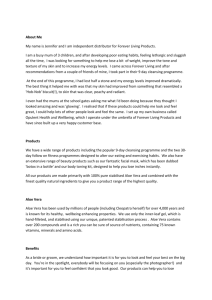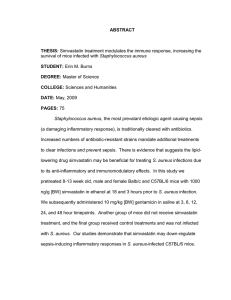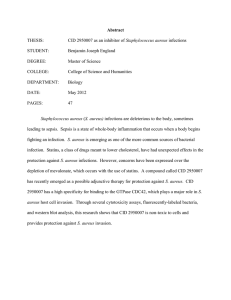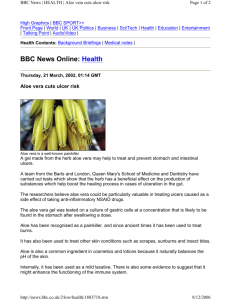Document 13310584
advertisement
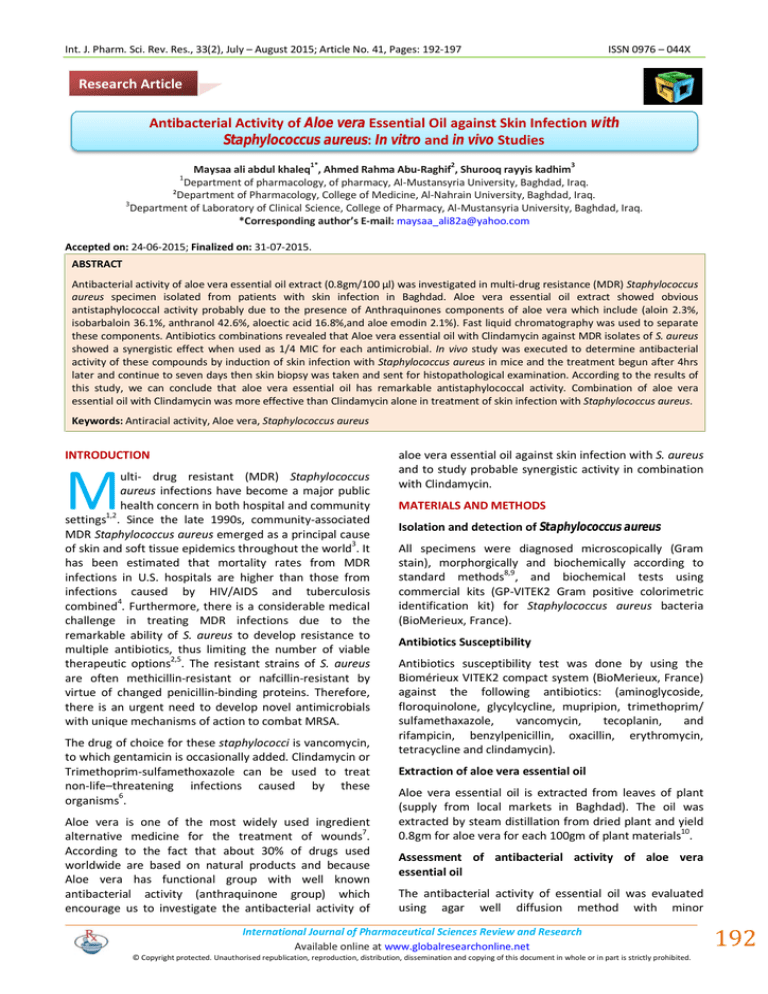
Int. J. Pharm. Sci. Rev. Res., 33(2), July – August 2015; Article No. 41, Pages: 192-197 ISSN 0976 – 044X Research Article Antibacterial Activity of Aloe vera Essential Oil against Skin Infection with Staphylococcus aureus: In vitro and in vivo Studies 1* 2 3 Maysaa ali abdul khaleq , Ahmed Rahma Abu-Raghif , Shurooq rayyis kadhim Department of pharmacology, of pharmacy, Al-Mustansyria University, Baghdad, Iraq. ²Department of Pharmacology, College of Medicine, Al-Nahrain University, Baghdad, Iraq. 3 Department of Laboratory of Clinical Science, College of Pharmacy, Al-Mustansyria University, Baghdad, Iraq. *Corresponding author’s E-mail: maysaa_ali82a@yahoo.com 1 Accepted on: 24-06-2015; Finalized on: 31-07-2015. ABSTRACT Antibacterial activity of aloe vera essential oil extract (0.8gm/100 µl) was investigated in multi-drug resistance (MDR) Staphylococcus aureus specimen isolated from patients with skin infection in Baghdad. Aloe vera essential oil extract showed obvious antistaphylococcal activity probably due to the presence of Anthraquinones components of aloe vera which include (aloin 2.3%, isobarbaloin 36.1%, anthranol 42.6%, aloectic acid 16.8%,and aloe emodin 2.1%). Fast liquid chromatography was used to separate these components. Antibiotics combinations revealed that Aloe vera essential oil with Clindamycin against MDR isolates of S. aureus showed a synergistic effect when used as 1/4 MIC for each antimicrobial. In vivo study was executed to determine antibacterial activity of these compounds by induction of skin infection with Staphylococcus aureus in mice and the treatment begun after 4hrs later and continue to seven days then skin biopsy was taken and sent for histopathological examination. According to the results of this study, we can conclude that aloe vera essential oil has remarkable antistaphylococcal activity. Combination of aloe vera essential oil with Clindamycin was more effective than Clindamycin alone in treatment of skin infection with Staphylococcus aureus. Keywords: Antiracial activity, Aloe vera, Staphylococcus aureus INTRODUCTION M ulti- drug resistant (MDR) Staphylococcus aureus infections have become a major public health concern in both hospital and community settings1,2. Since the late 1990s, community-associated MDR Staphylococcus aureus emerged as a principal cause of skin and soft tissue epidemics throughout the world3. It has been estimated that mortality rates from MDR infections in U.S. hospitals are higher than those from infections caused by HIV/AIDS and tuberculosis combined4. Furthermore, there is a considerable medical challenge in treating MDR infections due to the remarkable ability of S. aureus to develop resistance to multiple antibiotics, thus limiting the number of viable therapeutic options2,5. The resistant strains of S. aureus are often methicillin-resistant or nafcillin-resistant by virtue of changed penicillin-binding proteins. Therefore, there is an urgent need to develop novel antimicrobials with unique mechanisms of action to combat MRSA. The drug of choice for these staphylococci is vancomycin, to which gentamicin is occasionally added. Clindamycin or Trimethoprim-sulfamethoxazole can be used to treat non-life–threatening infections caused by these organisms6. Aloe vera is one of the most widely used ingredient alternative medicine for the treatment of wounds7. According to the fact that about 30% of drugs used worldwide are based on natural products and because Aloe vera has functional group with well known antibacterial activity (anthraquinone group) which encourage us to investigate the antibacterial activity of aloe vera essential oil against skin infection with S. aureus and to study probable synergistic activity in combination with Clindamycin. MATERIALS AND METHODS Isolation and detection of Staphylococcus aureus All specimens were diagnosed microscopically (Gram stain), morphorgically and biochemically according to standard methods8,9, and biochemical tests using commercial kits (GP-VITEK2 Gram positive colorimetric identification kit) for Staphylococcus aureus bacteria (BioMerieux, France). Antibiotics Susceptibility Antibiotics susceptibility test was done by using the Biomérieux VITEK2 compact system (BioMerieux, France) against the following antibiotics: (aminoglycoside, floroquinolone, glycylcycline, mupripion, trimethoprim/ sulfamethaxazole, vancomycin, tecoplanin, and rifampicin, benzylpenicillin, oxacillin, erythromycin, tetracycline and clindamycin). Extraction of aloe vera essential oil Aloe vera essential oil is extracted from leaves of plant (supply from local markets in Baghdad). The oil was extracted by steam distillation from dried plant and yield 0.8gm for aloe vera for each 100gm of plant materials10. Assessment of antibacterial activity of aloe vera essential oil The antibacterial activity of essential oil was evaluated using agar well diffusion method with minor International Journal of Pharmaceutical Sciences Review and Research Available online at www.globalresearchonline.net © Copyright protected. Unauthorised republication, reproduction, distribution, dissemination and copying of this document in whole or in part is strictly prohibited. 192 © Copyright pro Int. J. Pharm. Sci. Rev. Res., 33(2), July – August 2015; Article No. 41, Pages: 192-197 11 modifications . The broth micro dilution method was used to determine minimum inhibitory concentration (MIC). All tests were performed in mueller hinton broth (Salucea (Netherlands) supplemented with Tween 80 12 (BDH (England) at a final concentration of 0.5% (v/ v) . Fractional inhibitory concentration values (FICs) for antimicrobials combinations was used to determine the effect of antimicrobials combinations on multidrug resistance (MDR) strains of bacteria. FIC values used to assess the synergism between Clindamycin (Saudia Arabia) with aloe vera essential oil for S. aureus13. Separation of active ingredient of aloe vera essential oil Separation of active ingredients of aloe vera essential oil was done by FSL (Fast Liquid Chromatographic) (Shimadzu (North Amerika) equipped with binary delivery pump model 2010, using 3µ particle size column (50 × 4.6 mm H.D) C-18 (Injection 10 µl of essential oil in column), Mobile phase: 0.01M ammonium phosphate buffer (BDH(England)) A: acetoitrile B (BDH(England)). Eluted by linear gradient from 0-100% B in 10 min. Detection of eluted peak were monitored by UV-Vis spectrophotometer (Cecil (France)) set at 254nm, flow rate 1.0 ml/min, temperature 30˚C14. Animals experiment (In vivo method) Thirty five healthy, domestic male mice, weighing 23-25 gram were used in this study; they were obtained from animal house in high institute for infertility diagnosis and assisted reproductive technologies, in the period between August/2014 to October/2015. These mice were kept in separated cages; the room temperature was maintained at 20 -25˚C. Animals grouping: The mice randomly divided into five groups (n=7, each) according to following: Group 1(control): control group infected just by phosphate buffer saline (China). Group 2(induction group): infected by bacteria without treatment. Group3: treated with aloe vera essential oil alone for 7 days. Group 4: treated with clindamycin solution 1% (Saudia Arabia) alone for 7 days. Group 5: treated with combination of clindamycin solution and aloe vera essential oil for 7 days. For preparation of inoculate, the bacteria were sub cultured onto brain heart agar (BHA) (Oxoid (England)) and incubated at 37°C overnight. Then one colony was inoculated into brain heart broth (BHB) (Oxoid (England)) and incubated overnight at 37°C, the overnight culture was diluted 1:100 in fresh BHB and grown until the midexponential phase (approximately 3 hours). The bacteria washed twice and resuspended in sterile phosphate 15 buffered saline (PBS) . Before inoculation the mouse models of bacterial skin infection were sedated with ISSN 0976 – 044X ether. The flanks of the sedated mice were shaved with clippers when necessary and cleansed with an ethanol solution (BDH (England)), and then make wound by scalpel cuts. The wounds were subsequently inoculated by 50 µl of the bacterial suspension. Then the mice were returned to their cages and observed. All mice had free access to food and water throughout the duration of the experiments. Animals were observed daily and skin lesion size, swelling, redness, amount of buss were noticed. The treatments with antimicrobial used in this study begin after 4 hrs of bacterial inoculation and continued at the regimens of 7 days15,16. Statistical Analysis Data were analyzed using SPSS version 16 and Microsoft Office Word and Excel 2007. Nominal data were expressed as number and percent. Independent sample T-test was used for comparison of mean. P-value less than 0.05 were considered significant difference. RESULTS Out of 300 specimens obtained from different skin infection, 58 isolates (19.3%) were S. aureus. Identification was performed using the commercially available identification Vitek2 GP card. Staphylococcus aureus specimens are highly susceptible to the most of antimicrobial agents (aminoglycoside, floroquinolone, glycylcycline, mupripion, trimethoprim/ sulfamethaxazole, vancomycin, tecoplanin, and rifampicin), and highly resistance to benzylpenicillin and oxacillin, while show moderate resistance to erythromycin, tetracycline and Clindamycin. The percentage of resistant isolates to each antibiotic is shown in Figure (1). Minimum inhibitory concentration of aloe vera essential oil for highly resistance S. aureus isolates (n=10) as followed: 7 isolates with MIC=0.8 gm/100µl, and 3 isolates with MIC= 0.4 gm/100µl (Table 1) while MIC of Clindamycin for isolates was determined using VITEK 2 AST method which represent <=0.25. The effects of aloe vera essential oil alone and in combination with clindamycin against S. aureus in different are shown in table (1). The treatments with antimicrobial used in this study for in vivo study begin after 4 hrs of bacterial inoculation and continued at the regimens of 7 days. Then after seven day part of lesion area was tested for histopathological examination. Group 1 (control): the mice infected just by phosphate buffer saline, no lesion, no redness, no swelling, no death, and histopathological section showed normal skin without inflammatory cell infiltration, also no vascular congestion, no edema and no necrosis as showed in figure (2). Group 2 (induction group): in this group the mice infected by S. aureus and left without treatment, skin lesion was International Journal of Pharmaceutical Sciences Review and Research Available online at www.globalresearchonline.net © Copyright protected. Unauthorised republication, reproduction, distribution, dissemination and copying of this document in whole or in part is strictly prohibited. 193 © Copyright pro Int. J. Pharm. Sci. Rev. Res., 33(2), July – August 2015; Article No. 41, Pages: 192-197 occurred (1cm) with redness, swelling and pus, five mice dead in the first day. Under histopathological examination heavy infiltration of dermis and subcutaneous tissue by acute inflammatory cell predominantly neutrofil, market edema with proteinaceous exudates, and vascular congestion was shown as in figure (3). ISSN 0976 – 044X necrotic depris, extravagated red blood cell and pinkish oxidate (pus) as shown in figure (5). Group 5 (Aloe vera + Clindamycin): healing in this group begun in third day, there is little pus and little redness was remaining; one mouse died on first day, histopathological examination showed mild edema of dermis and subcutaneous tissue, scanty inflammatory cell infiltration with no vascular congestion as shown in figure (6). Group 3 (Aloe vera): in this group four mice died in first day, other suffers from skin lesion (0.6cm), redness, swelling and pus until third day all these parameter decreased and healing begun. The histopathological examination show very minimal acute inflammatory cell infiltration and edema without vascular congestion as shown in figure (4). Group 4 (Clindamycin): in this group pus, redness and lesion (1 cm) remain until day seven and three mice died in second day. Histopathological examination showed thickness of epidermis, heavy infiltration of dermis and subcutaneous tissue by acute inflammatory cell with Figure 1: Resistant S. aureus isolates to antimicrobial agents (n=58) Table 1: Effect of aloe vera essential oil alone and in combination with clindamycin on MDR S. aureus isolates (n=10) FIC Values Isolates No. Aloe vera MIC (gm/100µl) Aloe vera 1/4 MIC Clindamycin 1/4 MIC 1/4 +1/4 MIC 1/2 +1/2 MIC FIC interpretation 25 0.8 - + - - 0.5 Syn. 26 0.8 + + + - 0.5 Syn. 28 0.4 - + - - 0.5 Syn. 29 0.8 - + - - 0.5 Syn. 30 0.8 - + - - 0.5 Syn. 31 0.8 + + - - 0.5 Syn. 39 0.8 - + - - 0.5 Syn. 49 0.8 - + - - 0.5 Syn. 52 0.4 - + - - 0.5 Syn. 54 0.4 + + - - 0.5 Syn. Mean 170 0.0008 mg 1.7mg P-Value 0.312 0.312 *Where – mean no growth while + mean growth. The fractional inhibitory concentration (FIC) was determined as follows: (≤0.5) synergism, (0.5–<1) additive, (1–<4) indifference, (≥4) antagonism. P-value less than 0.05 were considered significant. Figure 2: Section of mouse infected by phosphate buffer saline (H×E) in 40×- Power Figure 3: Section of mouse infected by S. aureus without treatment (H×E) in 40× Power International Journal of Pharmaceutical Sciences Review and Research Available online at www.globalresearchonline.net © Copyright protected. Unauthorised republication, reproduction, distribution, dissemination and copying of this document in whole or in part is strictly prohibited. 194 © Copyright pro Int. J. Pharm. Sci. Rev. Res., 33(2), July – August 2015; Article No. 41, Pages: 192-197 ISSN 0976 – 044X (A2) Figure 4: Section of mouse infected by S. aureus treated with aloe vera (H×E) in 40×- Power Figure 7: HPLC chromatography of aloe vera standard and sample, A1: aloe vera standard, A2: aloe vera sample DISCUSSION In the present study, correct identification rate of S. aureus in this study was representing 100% (58/58) other study found that correct identification rates of S. aureus were 99.5%17. In this study S. aureus isolate represent 19.3% among patients with skin and soft tissue infection which similar to study done in Ethiopia in which S. aureus represent 19 % among patient with infected wound18. Figure 5: Section of mouse infected by S. aureus treated with clindamycin (H×E) in 40×- Power Zone of inhibition of aloe vera essential oil against S. aureus was ranging from 15.2 to 26.8mm after 48 hrs, and there is no effect of essential oil on three isolates. Other investigators indicated that the maximum zone of inhibition against S. aureus is 12mm19. In this study it was found that MIC of aloe vera essential oil ranging from 0.4-0.8 gm/100ml. Other study showed higher and lower MIC values of aloe vera extract are 0.5 and 0.03 gm/100ml respectively20. Susceptibility test was conducted for all S. aureus isolates against different antibiotics as following: to β- lactam antibiotics (benzyl penicillin MIC ≥5µg/ml and oxacillin MIC ≤0.25- ≥4µg/ml) S. aureus isolates demonstrated a resistance rate reached to 100%, 86% respectively. Figure 6: Section of mouse infected by S. aureus treated with combination of aloe vera and clindamycin (H×E) in 40×- Power (A1) Mean while all S. aureus isolates were sensitive to aminoglycosides group (gentamycin MIC ≤0.25- 1µg/ml and tobramycin MIC ≤1µg/ml), fluoroquinolones (levofloxacin MIC ≤0.12- ≥2µg/ml and moxifloxacin MIC ≤0.25µg/ml), glycylcycline antibiotic (tigacyclin MIC ≤0.120.25µg/ml), , mupripion MIC ≤2- ≥8µg/ml, and trimethoprim/ sulfamethaxazole MIC ≤10- ≥20µg/ml (i.e 0% resistance for all antibiotics). Three isolates of S. aureus (5%) in this study showed resistance to vancomycin, many studies demonstrate that among all tested antibiotics, vancomycin seem to be the 19 most effective antibiotic for S. aureus . The susceptibility to this antibiotic regarded it as drug of choice to treat severe infection caused by S. aureus that resistance to methicillin and other β- lactam antibiotics. 21 Nair found that resistance rate for rifampicin and clindamycin reach up to 2.7%, 1.4% respectively which agree with the result of present study. Other study International Journal of Pharmaceutical Sciences Review and Research Available online at www.globalresearchonline.net © Copyright protected. Unauthorised republication, reproduction, distribution, dissemination and copying of this document in whole or in part is strictly prohibited. 195 © Copyright pro Int. J. Pharm. Sci. Rev. Res., 33(2), July – August 2015; Article No. 41, Pages: 192-197 showed that resistance of S .aureus to clindamycin was 20.3%22. However, widespread use of clindamycin antibiotic has led to an increase in the number of 23 Staphylococcal strains acquiring resistance to it . In this study MDR isolates represent 81% for S. aureus tested strains. Those strains were resistant to all of the agents in two or more classes of antibiotic24. The result of present study was agreement Nair21 who found that MDR S. aureus was 78%. Synergistic effect was seen from combination of clindamycin with aloe vera essential oil against most S. aureus isolates as shown in table (1). The growth of the organism was clearly observed in all inoculated mice. Lesions cultures was confirmed the infections by bacteria. After usage of the plants as topical treatment for one week, the lesions and wounds were healed dramatically. Control groups were used to prove that healing was not spontaneously. In recent years, different reports from different countries were indicated that there were antimicrobial activities of medicinal plants, for many years, the effect of herbal medicine on burn wound has been noted. Herbal products seem to possess moderate efficacy and are less expensive as compared with synthetic drugs. Many plants and plants-derived products have been shown to possess potent wound-healing activity25. In-vivo-sensitivity of the plants studied on the infected mice proved to be very active. All the infected mice were cured by local application of the aloe vera on the lesions. No spontaneous improvement was detected on the infected control mice. The result of histopathological examination in the present studies showed that antibacterial activity of aloe vera essential oil alone and in combination with clindamycin was greater than antibacterial activity of clindamycin alone, this effect may belong to the active compound in the aloe vera which have bactericidal effect against S. aureus. The use of that aloe vera in the form of topical therapy in infected mice was proved the affectivity of aloe vera plants as medicinal 20 purpose . Most of the medicines are mixture of many plants, but none of these traditional ointments were scientifically studied. In the current study, aloe vera extract was compared with clindamycin as the standard treatment for burn wounds in mice. The actual mechanism of improved healing is still unclear, the probable mechanism are providing necessary material for healing, increasing blood flow to burn area, decreased inflammatory response, and decreasing rate of infection. A new skin medication can be introduced by usage of herbal medicines with fewer adverse effects and shorten the period of healing thus decrease the rate of hypertrophic scar. CONCLUSION Aloe vera essential oil has antibacterial effect against skin infection with Staphylococcus aureus and combination of ISSN 0976 – 044X aloe vera with Clindamycin shows synergistic effect and is more effective than Clindamycin alone. REFERENCES 1. Naimi TS, LeDell KH, ComoSabetti K, Borchardt SM, Boxrud DJ, Etienne J, Johnson SK, Vandenesch F, Fridkin S, O'Boyle C, Danila RN, and Lynfield R. “Comparison of communityand health care-associated methicillin-resistant Staphylococcus aureus infection”. 2003, JAMA 290:2976– 2984.doi:10.1001/jama.290.22.2976. 2. Tsuji BT, Rybak MJ, Cheung CM, Amjad M, and Kaatz GW. “Community- and health care-associated methicillinresistant Staphylococcus aureus: a comparison of molecular epidemiology and antimicrobial activities of various agents”. Diagn. Microbiol. Infect. Dis. 58, 2007, 41– 47.doi:10.1016/j.diagmicrobio.2006.10.021. 3. Stryjewski ME, and Chambers HF. "Skin and soft-tissue infections caused by community-acquired methicillinresistant Staphylococcus aureus”. Clin. Infect. Dis. 46(Suppl 5), 2008, S368–S377. doi:10.1086/533593. 4. Boucher HW, and Corey GR. “Epidemiology of methicillinresistant Staphylococcus aureus". Clin. Infect. Dis. 46(Suppl 5), 2008, S344–S349.doi:10.1086/533590. 5. Chambers HF, and Deleo FR. “Waves of resistance: Staphylococcus aureus in the antibiotic era”. Nat. Rev. Microbiol. 7, 2009, 629–641. doi:10.1038/nrmicro2200. 6. Warren Levinson MD. “Review of Medical Microbiology th and Immunology”, 12 edition, Mc-Graw-Hill-Newyork, 2012, 109-117. 7. Bruneton J. “Pharmacognosy, Phytochemistry”. Medicinal plants, Lavoisiler Publishing Co., France, 1995, 265-380. 8. Collee J.G.; Fraser A.G.; Marmion B.P.; and Simmons A. “Mackie and McCartney practical medical microbiology”. th 14 edition: Churchill Livingstone, London, 1996, 14. 9. Green wood O.; Slack R.; and Penther J. “Medical th Microbiology”. 15 edition, Churchill Livingstone, London, 1997. 10. Walton and Brown (1999): Chemical from plants, Imperial College Press. 11. Dahiya P.; and Purkayastha S. “Phytochemical analysis and antibacterial efficacy of Dill seed oil against Multi- drug resistant clinical isolates”. Asian Journal of pharmaceutical and clinical research. Academic sciences, Issue 2, Vol. 5, 2012, issn 0974-2441. 12. Clinical and Laboratory standards Institute/ National committee for clinical laboratory standards (CSLI/NCCLs). “Performance standards for antimicrobial susceptibility testing”. Fifteenth information supplement, Wayne, PA., 2005 CLSI/NCCLS document M100-S15. 13. Levinson W.; and Jawetz E. “Medical Microbiology and th Immunology”, Examination and board review 5 edition, Lang Medical Books/Mc-Graw-Hill, Newyork, 1998. 14. Subbiah rajasekaran. “Antioxidant effect of Aloe vera gel in Streptozocin- induced diabetics in rat”. Pharmacological reports, 57, 2006, 90-96. 15. Cho JS.; Zussman J.; Donegan NP.; Romos RI.; Garcia NC.; Uslan DZ.; Iwakura Y.; Simon SI.; Cheung AL.; Modlin RL.; International Journal of Pharmaceutical Sciences Review and Research Available online at www.globalresearchonline.net © Copyright protected. Unauthorised republication, reproduction, distribution, dissemination and copying of this document in whole or in part is strictly prohibited. 196 © Copyright pro Int. J. Pharm. Sci. Rev. Res., 33(2), July – August 2015; Article No. 41, Pages: 192-197 Kim J.; and Miller LS. “Non invasive in vivo imaging to evaluate immune responses and antimicrobial therapy against Staphylococcus aureus and USA 300 MRSA skin infections”. J. Invest. Dermatol. 131, 2011, 907-915. 16. Fang RC.; Kryger ZB.; Buck DW.; Dela Garza M.; Galiano RD.; and Mustoe TA. “Limitations of the db/db mouse in translational wound healing research: is the 10 Polygenic mouse model superior? Wound”. Repair Regen, 18, 2010, 605-613. 17. Edward J.P. Cartwright; Gavin K. Paterson; Kathy E. Raven; Ewan M. Harrison; Theodore Gouliouris; Angela Kearns; Brune Pinchon; Giles Edwards; Robert L. Skov; Anders R. Larsen; Mark A. Holmes; Julian Parkhill; Sharon J. Peacock; and M. Estee Tӧrӧk .”Use of Vitek 2 antimicrobial susceptibility profile to identify mec C. in Methicillinresistant Staphylococcus aureus”. J. Clin. Microbial., 51(8), 2013, 2732-2734. 18. Girma Godebo; Geber Kibru; and Himanot Tassew. “Multidrug-resistant bacterial isolates in infected wounds at Jimma University Specialized Hospital, Ethiopia”. Annals of clinical microbiology and antimicrobials. No. 17(12), 2013, doi:10.1186/1476-0711-12-17. 19. Fatemeh Nejatzadel- Barandozi. “Antibacterial activities and antioxidant capacity of Aloe vera”. NejatzadehBarandozi Organic and Medicinal Chemistry Letters, 3, 2013, 5. 20. Babakir-Mina M.; Othman N.; Najmuldeen HH.; Norri CK.; Fatah CF.; Perno CF.; and Ciotti M. “Antibiotic susceptibility ISSN 0976 – 044X of Vancomycin and Nitrofurantoin in Staphylococcus aureus isolated from burnt patients in Sulaimaniyah, Iraq Kurdistan”. New Microbiol, 35(4), 2012, 439-46. 21. Nair Kaur; R. Prasad; and A. Varma. “Antibiotic resistance among clinical isolates of Staphylococcus aureus and usefulness of antibiogram”. Int. Journal Pharm. Bio. Sci. 4(1), 2013, (B)957-964, ISSN 0975-6299. 22. Lt. Col Mahima Lall; and Bring A.K. Sahni. “Prevalence of inducible Clindamycin resistance in Staphylococcus aureus isolated from clinical samples”. Medical Journal Armed Forces INDIA. 70, 2014, 43-47. 23. Gadepalli R.; Dhawan B.; Mohanty S.; Kapil A.; Das BK.; and Chaudhry R. “Inducible Clindamycin resistance in clinical isolates of Staphylococcus aureus”. Indian J. Med. Res., 123, 2006, 571-3. 24. Saiman L. “Clinical utility of synergy testing for multidrugresistant Pseudomonas aeruginosa isolated from patients with cystic fibrosis”. Paediatr. Respir.Rev. 8, 2007, 249– 255. 25. Hosseini SV.; Niknahad D.; Fakhar N.; Rezaianzadeh A.; and Mehrabani D. “The healing effect of honey, putty, vitriol and aloe vera in Pseudomonas aeruginosa infected burns in experimental rat model”. Asian J. Anim. Vet. Adv., 6, 2011, 572-579. 26. Maenthaisong R.; Chaiyakunapruk N.; Niruntraporn S.; and Kongkaew C. “The efficacy of Aloe vera used for burn wound healing: a systematic review”. Burns. 33, 2007, 71318. Source of Support: Nil, Conflict of Interest: None. International Journal of Pharmaceutical Sciences Review and Research Available online at www.globalresearchonline.net © Copyright protected. Unauthorised republication, reproduction, distribution, dissemination and copying of this document in whole or in part is strictly prohibited. 197 © Copyright pro
